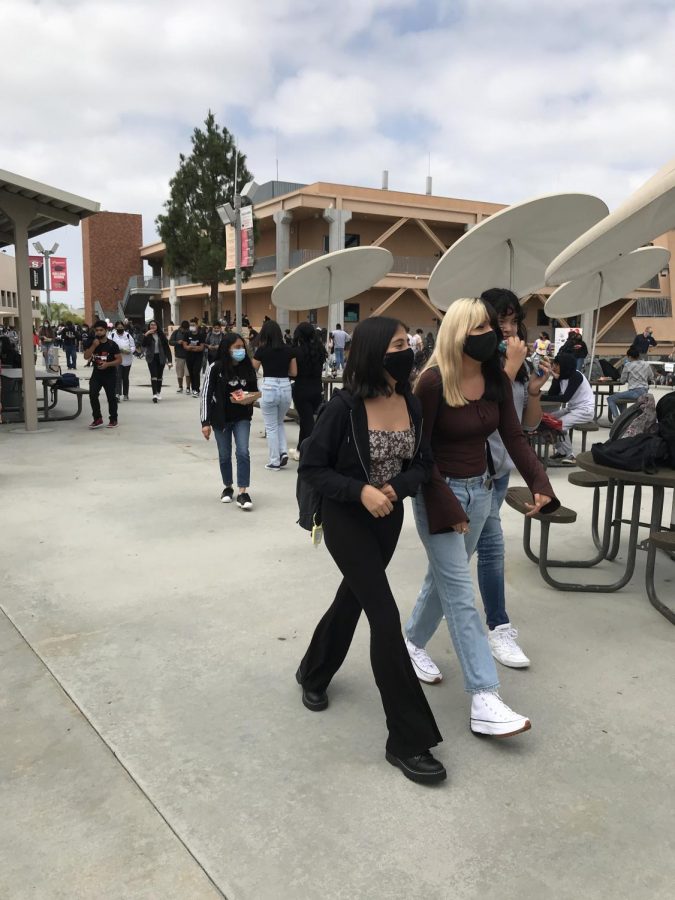Segerstrom’s New Controversial COVID-19 Protocols
Image courtesy of Avery Ngo
Students walk around the campus during their lunch break, following mask protocol.
September 13, 2021
After almost a year and a half of distance learning, students are back at Segerstrom High School under these unprecedented circumstances. With the rise of the Delta Variant, Segerstrom has implemented a variety of new, yet controversial protocols, to minimize the spread of COVID-19.
“I am very excited for school to start back again. I miss my friends, but I am a little scared about the Delta Variant. I don’t want to put my grandparents or siblings at risk,” says Mia Gonzalez (11).
The school’s policy includes the mask mandate where students are required to wear masks both indoors and recommend students wear masks outdoors. No touching is allowed, and handwashing stations have been erected throughout campus. In addition to this, teachers are given a set of glass dividers to separate desks in classrooms. Use of these dividers are left to the discretion of the individual teachers. Teachers are also supplied with new technological equipment, including new microphones and TVs.
However, there have been a myriad of complaints concerning the District and school’s board approach to COVID-19.
“I don’t know if the mask thing is working. During lunch, most of the people around me are not wearing masks even when they are not eating. I am afraid of walking by someone, and potentially getting affected,” says Nadia Tran (12).
The problem with the mask mandate is that there has not been a clear protocol established for eating. Many students are choosing not to wear a mask during the entire lunch break.
“I also am concerned about passing periods. To get into the English building, I find myself surrounded on all sides by other students. We are literally touching each other because there is so much traffic to get into the English building,” Tran says.
While most students are wearing masks during the passing period, students may have a higher risk of getting COVID-19 when they enter the English building. Because there is only one entrance, the English building hallways are often packed- it can take several minutes just to get into the building. This congregation of students may pose a risk to the students’ health. It is worth noting that the school’s administration has tried to mitigate the congestion with masks as well as controlling the flow for which students are exiting and entering. However, those rules are hard to enforce, and many students move in the incorrect direction, worsening the congestion.
Finally, there have been concerns about the inconsistencies within the school’s COVID-19 policy.
Two weeks ago, one of the members of Segerstrom’s water polo team was infected with COVID-19.
“Because I was unvaccinated, I was sent home to quarantine for two weeks,” says Dominic Truong (12). “Even though other members of the polo team were exposed, they could stay at school because they were vaccinated.”
However, it seems as if other students are sent home regardless of their vaccination status.
“I was sent home to quarantine for two weeks after I was exposed to COVID-19 by one of the other students even though I was vaccinated. In fact, they didn’t even ask about my vaccination status,” says Bella Do (12).
Do and Truong are not the only ones who have seen the inconsistencies within the policy. Other exposed vaccinated students have been quarantined, while other exposed vaccinated students have not been. While the administration may be following guidelines that take into account how long and close the exposure is, the rules have not been explicitly made clear, especially when it comes to the relevance of vaccination status. However, while this inconsistency does leave some room for the school’s policy to improve, it is important to acknowledge that these are new and trying times for everyone — including the school.
Students should do their best to follow school protocols, especially because the protocols are designed to maximize student health despite the inconsistencies.
“Even though there’s always that health risk, I am so grateful to be back. I am going to do my best to keep myself and others safe. I don’t want to go back home!” says Tran.

